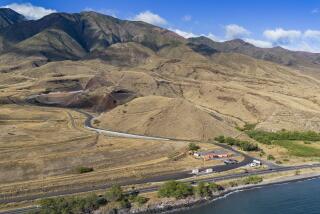Smithsonian Releases Hawaiian Bones, Ignores Priestly Threats
- Share via
WASHINGTON — A group of native Hawaiian families today will receive the last of their ancestors’ bones at the Smithsonian, which rejected a rival claim by two purported royal priests who threatened spiritual vengeance if they were not awarded the remains.
After a private religious ceremony at the Smithsonian’s National Museum of Natural History, the officially recognized delegation will carry away the 135 skeletal remains in woven ti leaf baskets for burial on the island of Kauai.
Museum director Frank Talbot rejected a competing claim for the bones by Ed Kaiwi of Kauai and his cousin, Eric Kanakaole of Maui, who appeared at the museum last week purporting to be kahunas, or priests descended from Hawaiian royalty.
The tattooed men, who wore lava-lava loinclothes and braided leaf necklaces and carried a carved staff representing the Hawaiian god of fertility, threatened the vengeance of the heavens if the Smithsonian released the bones to anyone else.
“You move the bones, and you all are going to die,” Kaiwi said he told museum officials.
But Talbot said the pair lacked the status of a legitimate group, so their claim was not referred to a review board created by a 1989 federal law to resolve disputes over repatriation of Smithsonian bone collections.
The Kauai group designated to receive all 135 bones remaining in the museum’s Hawaiian collection has the blessing of two native Hawaiian organizations recognized by the 1989 statute. They are the Hui Malama, a nonprofit organization of native Hawaiians, and the state’s Office of Hawaiian Affairs, which represents native Hawaiian interests.
Burial of ancestral remains is a sensitive issue in Hawaii, where land sacred to natives might be valuable real estate sought for development.
The bones removed from the Smithsonian will be buried on land set aside by a developer on a 12-acre resort property now under construction. Kaiwi and Kanakaole contend that the bones will be buried in the wrong place.
The 1989 law creating the Smithsonian’s new National Museum of the American Indian specifies that an inventory of skeletal remains must be taken, and bones must be returned to any native American tribal group that can prove an ancestral claim to them.
The Natural History Museum has more than 18,000 skeletal remains. An initial set of 86 Hawaiian bones was repatriated last year.
More to Read
Sign up for Essential California
The most important California stories and recommendations in your inbox every morning.
You may occasionally receive promotional content from the Los Angeles Times.













